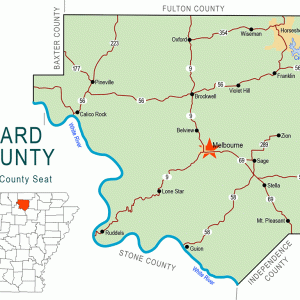calsfoundation@cals.org
Pineville (Izard County)
| Latitude and Longitude: | 36º49’06″N 092º06’26″W |
| Elevation: | 682 feet |
| Area: | 1.81 square miles (2020 Census) |
| Population: | 154 (2020 Census) |
| Incorporation Date: | October 11, 1973 |
Historical Population as per the U.S. Census:
|
1810 |
1820 |
1830 |
1840 |
1850 |
1860 |
1870 |
1880 |
1890 |
1900 |
|
– |
– |
– |
– |
– |
– |
– |
– |
– |
– |
|
1910 |
1920 |
1930 |
1940 |
1950 |
1960 |
1970 |
1980 |
1990 |
2000 |
|
– |
– |
– |
– |
– |
– |
– |
163 |
220 |
246 |
|
2010 |
2020 |
|
|
|
|
|
|
|
|
|
238 |
154 |
|
|
|
|
|
|
|
Pineville, a small town located in northwest Izard County, was once a center of commerce and trade for area residents. Though most area residents farmed the land or raised cattle, timber harvesting also played a role in the growth of the settlement.
Early settlers such as James, William, and Allen Whitfield were attracted to the White River valley for its rich farm land. By the 1830s, the military road that intersected with the road leading to Jacksonport (Jackson County) connected the area to the White and Black rivers, important trade routes.
Robert Calvin Matthews, who settled in the area by 1860, was a major influence in the development of the settlement. He built the area’s first house and, in 1861, built the town’s first store. Merchandise came by boat to Calico Rock (Izard County) and then by road to Matthews’s store. The Civil War delayed the development of the town. Matthews enlisted in the Confederate army and helped raise the Twenty-seventh Arkansas Infantry, a unit in which several local men served. During the war, Matthews’s store was burned, and his house was ransacked.
By 1867, Matthews built a cotton gin and a new two-story building, replacing his store. On April 22, 1867, a post office named Pineville was founded at the Matthews store with James B. Roe as postmaster. The name was chosen due to the large number of pine trees that grew in the area. On April 30, 1915, the office was discontinued. By 1920, Young Whitfield purchased the Matthews store and reestablished the post office under the name of Whit; the name remained Whit until reverting back to Pineville in 1922.
Soon after the Civil War, a log cabin was constructed, serving as the home of both a subscription school and church. In 1871, Matthews deeded a plot of land and donated materials for the construction of a new school building. The two-story structure, which also housed the Pineville Masonic Lodge No. 306, was completed in 1873. The lodge received its charter in 1873 but ceased operation during World War I. The town grew slowly and, by 1890, consisted only of a general store, a blacksmith, and the building that housed the Masonic lodge, church, and school. In 1912, a Cumberland Presbyterian church was organized with six charter members.
In the early 1900s, the Lacy-Pease Lumber Mill opened, harvesting the area’s timber. In the 1940s, the Ducker Planing Mill opened. The school was consolidated with Calico Rock in the 1940s, though elementary grades remained until 1951.
While the settlement never became large, Pineville was incorporated in 1973. In 2010, the population was listed at 238. As of 2010, the town consists of several small businesses, a city hall, a volunteer fire department, a post office, and churches.
For additional information:
Matthews, Perry E. “Capt. Robert Calvin Matthews and Pineville Community.” Izard County Historian 2 (July 1971): 2–8.
Stone, Elizabeth Woodcock. “An Old Community—A New City—Pineville.” Izard County Historian 6 (July 1975): 2–8.
Stowers, Juanita. The History and Families of Izard County, Arkansas. Paducah, KY: Turner Publishing Company, 2001.
Mike Polston
CALS Encyclopedia of Arkansas
 Izard County Map
Izard County Map 




Comments
No comments on this entry yet.